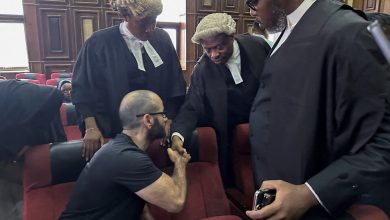How Journalists Wrestle With Covering Threats to Democracy

The banner headline on Friday’s print edition of The New York Times was pretty direct:
But for journalists, not every story is as black and white as a mob storming the United States Capitol to try to overturn a free election. Often, there are areas of gray.
Gerrymandering is a classic example. It’s not always easy to identify heroes and villains when writing about the redrawing of district boundaries. Republicans have had more success with redistricting lately, and they’ve often run afoul of voting rights laws, but both parties manipulate political maps for their own ends. In New York, for instance, Democratic legislators sought to maximize their number of House seats, only to run into a court order throwing out their maps.
So is gerrymandering a fundamental threat to democracy, as some would argue? Is it a tool politicians use to protect their jobs or gain an edge over rivals? Something in between? The details matter.
Journalists run into difficult questions like these every day:
-
How to calibrate a headline on a big story like the assault of Jan. 6, 2021.
-
How to correct misinformation when repeating it could amplify lies.
-
How seriously to take fringe groups that might seem inconsequential now, but could prove dangerous in the future.
-
Whether and how to quote politicians who make outlandish comments for the very purpose of generating a backlash.
-
How to cover campaigns that exclude reporters from their events or refuse to respond to basic questions.
There’s no handbook for any of this, but a group of activists and academics is trying to help.
A new 28-page report by Protect Democracy, a nonpartisan, nonprofit group, proposes guidelines for news outlets to help them distinguish between “normal political jockeying” and truly dangerous conduct. Its primary author was Jennifer Dresden, a former scholar at Georgetown University who has studied democracy around the world.
In an interview, Dresden said she was driven by the conviction, backed by decades of research, that “authoritarianism doesn’t happen overnight.” Like a stalagmite, it develops from the slow drip of infringements on freedoms and breaches of longstanding democratic rules and traditions. That process is now well underway in the United States, she worries.
The idea motivating the report, Dresden said, was to develop rules for thinking about how to evaluate whether something is “a systemic risk to democracy” — and expose it as such — or “just one loose cannon doing things that are problematic.”
Protect Democracy assembled a panel of academic luminaries for the project, including Sheri Berman, Larry Diamond, Timothy Snyder, Kim Lane Scheppele, Steven Levitsky and Daniel Ziblatt. The group also consulted editors at various news outlets, including The New York Times, to help gain insights into how newsrooms are approaching this task.
The panel reached a consensus on “seven basic tactics” authoritarian leaders and movements use to pursue and maintain power, which are listed verbatim below:
-
They attempt to politicize independent institutions.
-
They spread disinformation.
-
They aggrandize executive power at the expense of checks and balances.
-
They quash criticism and dissent.
-
They specifically target vulnerable or marginalized communities.
-
They work to corrupt elections.
-
They stoke violence.
Each bullet point comes with its own section, along with suggestions for journalists meant to influence their coverage. But the advice is all guided by the overarching question that animated the report: What’s politics as usual, and what’s not?
Dresden says there ought to be clearer standards than the Potter Stewart test — referring to the former Supreme Court justice, who famously said in a 1964 case that his method for identifying obscenity was “I know it when I see it.” There’s some wisdom in that trust-your-gut approach, but democracy is a lot more complicated than a pornographic film.
So the report contains advice like “explain and contextualize the reasons why institutions were designed as independent” and “rely on experts familiar with each particular institution’s history.”
Read More on the Jan. 6 House Committee Hearings
- The Meaning of the Hearings: While the public sessions aren’t going to unite the country, they could significantly affect public opinion.
- An Unsettling Narrative: During the first hearing, the House panel presented a gripping story with a sprawling cast of characters, but only three main players: Donald Trump, the Proud Boys and a Capitol Police officer.
- Trump’s Depiction: Former president Donald J. Trump was portrayed as a would-be autocrat willing to shred the Constitution to hang onto power.
- Liz Cheney: The vice chairwoman of the House committee has been unrepentant in continuing to blame Mr. Trump for stoking the attack on Jan. 6, 2021.
The Trump era prompted many mainstream news organizations to do exactly that. At one point, Slate, a left-leaning website that pioneered many aspects of early web journalism, ran a semiregular feature called “Is This Normal?” that aimed to answer readers’ questions about moves like Donald Trump’s firing of James Comey, the F.B.I. director whose role in the Russia investigation agitated the former president. (Spoiler alert: That was not normal.)
But all of us in the journalism business, admittedly, are still figuring out how best to cover what the weight of evidence suggests is an authoritarian moment with few parallels in our lifetimes.
In one measure of the challenge, researchers with the Center for Media Engagement at the University of Texas at Austin studied the views of 56 people who believed Trump won the 2020 election. The results are sobering: Participants “trusted unedited video content, personal experience, and their own research and judgment more than social media and news organizations,” they found.
The democracy beat is now everyone’s beat
The Trump era has prompted The Times and other news outlets to take steps to better organize and invest in coverage of democracy and efforts to undermine it.
The Washington Post, for instance, has assembled a nine-person “Democracy Team” and hired correspondents based in Arizona, Georgia and Michigan for what the paper is calling a first step in a larger strategy.
Its first editor is Griff Witte, a longtime foreign correspondent who said in an interview that his years abroad gave him “fresh eyes” in approaching the job.
From perches in London and Berlin, he covered the far right’s reaction to an influx of migrants from Africa and the Middle East, and witnessed up close how Viktor Orban, the prime minister of Hungary, “managed to use the mechanisms of democracy against democracy” to entrench his power.
“We have Jan. 6, which is highly visual and very dramatic,” Witte said, “but you also have a lot that is going on in a subterranean way that no one sees.”
The Times’s new executive editor, Joe Kahn, has been clear about his view of the paper’s responsibility to the public: that Times journalists cannot be “impartial” about whether the United States slides into autocracy. As he told David Folkenflik of NPR in a recent interview, “You can’t be committed to independent journalism and be agnostic about the state of democracy.”
The Times approaches this mandate broadly, reflecting the paper’s size and the sprawling, global nature of the topic.
Coverage of democracy is woven across multiple parts of the newsroom, including the politics desk, which covers campaigns and elections; the enterprise and investigative teams, which dig deep into stories that require more than the usual elbow grease; national correspondents across the United States, who cover everything from hurricanes to school shootings to big societal trends; international correspondents, based in many instances in countries that don’t have a free press; and the Washington bureau, which covers the White House, Congress and federal agencies.
The Times coordinates and pulls together highlights of that coverage under the rubric “Democracy Challenged.”
We need your input, too.
The Times has asked readers to tell us their concerns about the state and future of American democracy, and On Politics will regularly round up stories on this topic from colleagues across the newsroom. Expect to see new guest authors contributing to the newsletter in the weeks to come. And please drop us a line with your thoughts.
What to read about democracy
-
In case you missed it, Peter Baker wrote about the House panel’s laserlike focus on Trump’s culpability for the Jan. 6 riot. “In the entire 246-year history of the United States,” Baker writes, “there was surely never a more damning indictment presented against an American president than outlined on Thursday night in a cavernous congressional hearing room where the future of democracy felt on the line.”
-
States are spending millions to combat a “deluge of unfounded rumors and lies around this year’s midterm elections,” Cecilia Kang reports.
-
Matt Apuzzo and Benjamin Novak examine how Viktor Orban, the prime minister of Hungary, “has not hesitated to use the levers of government power to erode democratic norms and cement one-party rule” during a decade in power. Orban, as Elisabeth Zerofsky wrote for The New York Times magazine last year, has become a source of inspiration for some on the American right.
-
Danny Hakim and Alexandra Berzon take apart “2000 Mules,” a new movie about the 2020 election that makes a host of misleading and outright false claims.
-
In The Washington Post, Bob Woodward and Carl Bernstein reflect on how, after covering Richard Nixon’s downfall, “we believed with great conviction that never again would America have a president who would trample the national interest and undermine democracy through the audacious pursuit of personal and political self-interest.” But then, they write, “along came Trump.”
viewfinder
A sea of red
On Politics regularly features work by Times photographers. Here’s what Shuran Huang told us about capturing the image above:
It was a hot day at Union Square near Capitol Hill. Gun violence survivors and families of victims were waiting to hear from members of Congress at a gun control rally. Many wore red shirts bearing the words “Moms Demand Action.”
People were wiping sweat off their foreheads. Speaker Nancy Pelosi finally showed up. As she spoke, I noticed a woman in the crowd raising her hands and clapping to every line Pelosi said.
The speaker promised that Congress would pursue action on guns. “Why would someone be against raising the age so that teenagers do not have AK-47s?” she asked. “Why would someone not want protection in their home so that children cannot have access dangerously to guns?”
As Pelosi spoke, the woman’s hands appeared to hold both the speaker and the Capitol building in the center of the frame.
Thanks for reading. We’ll see you on Monday.
— Blake
Is there anything you think we’re missing? Anything you want to see more of? We’d love to hear from you. Email us at [email protected].




